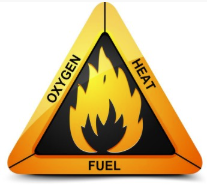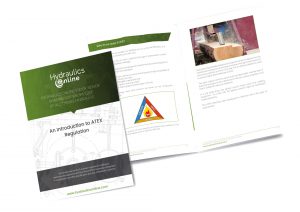Two:
The number of European ATEX directives: ATEX 137 and ATEX 95
100:
The number of years of technical experience within our engineering team.
Play it safe | Hydraulics Online provides certified, explosion-proof hydraulic equipment and components in accordance with the European ATEX directive.
Our technical team’s knowledge of the European ATEX directives and regulations means that we can provide intrinsically safe and ATEX-certified hydraulic equipment; meeting the explosion-proof standards through documented testing routines.
Because Hydraulics Online is independent and not tied to any one manufacturer, I know that they are giving us the best solution and the best products for that solution.
We can help you with everything from routine ATEX equipment maintenance work to highly explosive ATEX Zone 1 applications for clients in the petroleum refinery sector.
We source a wide variety of certified explosion-proof hydraulic valves (including Bosch Rexroth ATEX cetop solenoid valves), hydraulic cylinders, explosion-proof high-pressure pumps and motors with ATEX certification, tailor-made explosion-proof hydraulic power units for standards-compliant installation and operation in environments subject to explosions.
Please click on the links below for more ATEX hydraulic resources…
ATEX is based on the requirements of two European directives: one that applies to equipment manufacturers, and another for its end users.
Both directives came into effect on 1st July, 2003:
- ATEX 95 (for equipment and protective systems, equipment directive 94/9/EC) was introduced back in 1995 and an 8 year transition period was given for manufacturers to
 comply.
comply. - ATEX 137 (for the protection of workers, workplace directive 99/92/EC) was introduced in 1999 with a 4 year transition period granted for employers to comply.
The ATEX 95 (equipment 94/9/EC) directive only applied until 19th April 2016, when it was replaced by a new directive: Directive 2014/34/EU harmonised the laws of the EU Member States relating to equipment and protective systems intended for use in potentially explosive atmospheres.
Why do we need ATEX?
An explosion or fire naturally occurs when the right elements are present and combined in the right mixture – meaning that a fire is actually an event rather than a ‘thing’. Known collectively as the fire or combustion triangle, the three main elements that react together to create  a fire or explosion are:
a fire or explosion are:
- flammable material, the fuel;
- heat or an ignition source;
- oxygen or another oxidising agent.
Explosive atmospheres can be caused by flammable solids (or fibres), liquids, gases, mists vapours or by combustible dusts. Many substances need very little energy to react; the most flammable substances are gases and vapours.
Examples of potentially explosive atmospheres in the workplace could include vehicle paint spraying and workplaces handling fine organic dusts such as grain flour or wood. If there are enough of such substances, mixed with air, then a source of ignition is all that is needed to cause an explosion.
Sparks, flames, electric arcs and hot surfaces are all examples of ignition sources. Other potential hazards are:
- static electricity: these charges can end up resulting in a dangerous discharge and must be prevented;
- leakage currents: the overheating of surfaces in conductive equipment parts are capable of provoking an ignition and dangerous corrosion;
- overheating: if two parts of a rotating system were to contact each other, overheating may occur. This risk should always be prevented at the design stage;
- pressure compensation operators: equipment and protective systems must be fitted with integrated measuring, control and regulation devices that pressure compensations arising from them don’t generate shock waves or compressions;
- power failure: in the event of a power failure, some equipment and protective systems can experience additional risks;
- connections: equipment and protective systems must be fitted with suitable cable and conduit entries. When equipment and protective systems are intended for use in combination with other equipment and protective systems, the interface must be safe;
- radiation: electro magnetic waves, optical radiation, ionising radiation and ultrasound.
Hazardous areas or locations are classified within the ATEX directive in terms of zones, on the basis of the frequency and duration of the occurrences of an explosive atmosphere. Find out more about ATEX Area Classifications and ATEX Zones in the section below.
ATEX hazardous area classifications analyse and classify the environment where explosive atmospheres may occur – to aid the correct selection, installation and usage of equipment.
Flammable and/or combustible substances are materials which may form an explosive atmosphere either through being flammable themselves, or through being capable of producing a flammable gas, vapour or mist.
A ‘source of release’ is a point or location from which a flammable gas, vapour or liquid may be released into the atmosphere in such a way that an explosive gas atmosphere could be formed. The basic elements for establishing the classification of ATEX zones are the identification of the source of release and the determination of the grade of release:
-
continuous – release which is continuous or is expected to occur frequently or for long periods;
-
primary – release which can be expected to occur periodically or occasionally during normal operation*;
-
secondary – release which is not expected to occur in normal operation and, if it does occur, is likely to do so infrequently and for short periods.
(* Normal operation is defined as a situation when the equipment is operating within its design parameters.)
The extent of the hazardous area is based on the estimated or calculated distance over which an explosive atmosphere exists before it disperses to a concentration in air below its lower explosive limit.
Hazardous locations are then divided into two categories based on material type and are classified in terms of zones on the basis of the frequency and duration of the occurrences of an explosive atmosphere. The two categories are: (1) Gases, vapours and mists, and (2) Dusts.
Gases, Vapours and Mists
![]() ATEX Zone 0 – A place in which an explosive atmosphere, consisting of a mixture with air of dangerous substances in the form of gas, vapour or mist is present continuously, for long periods or frequently.
ATEX Zone 0 – A place in which an explosive atmosphere, consisting of a mixture with air of dangerous substances in the form of gas, vapour or mist is present continuously, for long periods or frequently.
![]() ATEX Zone 1 – A place in which an explosive atmosphere, consisting of a mixture with air of dangerous substances in the form of gas, vapour or mist is likely to occur in normal operation.
ATEX Zone 1 – A place in which an explosive atmosphere, consisting of a mixture with air of dangerous substances in the form of gas, vapour or mist is likely to occur in normal operation.
![]() ATEX Zone 2 – A place in which an explosive atmosphere, consisting of a mixture with air of dangerous substances in the form of gas, vapour or mist is not likely to occur in normal operation, but if it does occur, will persist for a short period only.
ATEX Zone 2 – A place in which an explosive atmosphere, consisting of a mixture with air of dangerous substances in the form of gas, vapour or mist is not likely to occur in normal operation, but if it does occur, will persist for a short period only.
Dusts
![]() ATEX Zone 20 – A place in which an explosive atmosphere in the form of a cloud of combustible dust in air is present continuously, for long periods or frequently. These areas may include the inside parts of equipment, such as mixers, silos, filters, mills, transfer pipes and closed conveyors.
ATEX Zone 20 – A place in which an explosive atmosphere in the form of a cloud of combustible dust in air is present continuously, for long periods or frequently. These areas may include the inside parts of equipment, such as mixers, silos, filters, mills, transfer pipes and closed conveyors.
![]() ATEX Zone 21 – A place in which an explosive atmosphere in the form of a cloud of combustible dust in the air is likely to occur in normal operation occasionally. This may include areas such as: emptying areas, places where dust accumulates and where the formation of air-dust mixtures is high.
ATEX Zone 21 – A place in which an explosive atmosphere in the form of a cloud of combustible dust in the air is likely to occur in normal operation occasionally. This may include areas such as: emptying areas, places where dust accumulates and where the formation of air-dust mixtures is high.
![]() ATEX Zone 22 – A place where an explosive atmosphere in the form of a cloud of combustible dust in air is not likely to occur but, will persist for a short period only. Areas may include storage facilities of closed packages, outlet sides of air filters and the surroundings of rarely opened equipment.
ATEX Zone 22 – A place where an explosive atmosphere in the form of a cloud of combustible dust in air is not likely to occur but, will persist for a short period only. Areas may include storage facilities of closed packages, outlet sides of air filters and the surroundings of rarely opened equipment.
The ATEX framework defines equipment categories and the corresponding hazardous area classifications in which the explosion-proof equipment can be used. Find out more about ATEX equipment in the section below.
The ATEX framework defines equipment categories and the corresponding hazardous area classifications in which the equipment can be used.
In most practical situations where flammable materials are used, it is difficult to ensure that an explosive atmosphere will never occur. It is also difficult to ensure that equipment will never give rise to a source of ignition. As a result, in areas where an explosive atmosphere has a high likelihood of occurring, reliance is placed on using apparatus that has a low likelihood of creating a source of ignition. Conversely, where the likelihood of an explosive atmosphere occurring is reduced, apparatus constructed to a less rigorous standard may be used.
ATEX equipment, ‘explosion-proof equipment’, is classified within the ATEX 95 (Equipment 94/9/EC) Directive in 3 categories. Higher categories can be used in lower categories, but not vice versa, e.g. equipment in group 2 or 3, cannot be used in group 1.The categories are:
- CATEGORY 1 equipment can be used in Zone 0 (gas) or Zone 20 (dust) atmospheres and is designed to ensure a very high level of safety when operated correctly, even in rare fault situations. The equipment must provide two independent protection methods and safety must still be maintained even if two faults exist simultaneously.
- CATEGORY 2 equipment can be used in Zone 1 (gas) or Zone 21 (dust) atmospheres and is designed to ensure a high level of safety during repeated error situations or normal equipment fault situations.
- CATEGORY 3 equipment can be used in Zone 2 (gas) or Zone 22 (dust) atmospheres and is designed to ensure a normal level of safety, during normal operation. The manufacturer’s declaration of conformity will often suffice and third party approval is not required.
ATEX equipment of a higher or lower category than that usually required should only be present in special circumstances e.g.:
- during maintenance operations where other effective precautions are given to control the risk;
- where workers are omitted from the dangerous area, and it will not be a hazard if there is ignition of an explosive atmosphere;
- where equipment of the required category is not available, but a lower category can be combined with other protective actions to achieve the purposes of these regulations.
The ATEX Equipment Directive also dictates marking and documentation requirements. The manufacturer must ensure that the following information is marked on the product in addition to the “Ex” symbol:
- manufacturer’s name and address;
- “CE” marking to show compliance with European Directive;
- Serial or type marking;
- Serial number (if applicable);
- Year of manufacture;
- Equipment group and class (1, 2 or 3);
- Marking of the gas (G) and/or the dust class (D);
- Other markings related to the safe use of the product, e.g. a temperature rating (a “T” marking), and occasionally a gas group.
ATEX equipment manufacturers must also be able to supply the correct ATEX certification / documentation to show that their product(s) are suitable for use within explosion-proof areas in the EU. These documents are the: EU Declaration of Conformity for products or the Certificate of Conformity for components.





